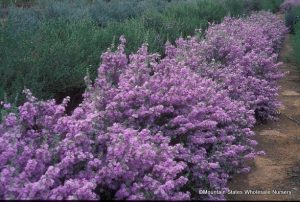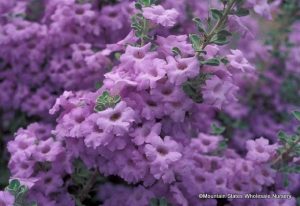
Lynn’s Legacy Texas sage is a standout. Photos courtesy: Mountain States Wholesale Nursery.
By Joe Pearl
In the world of Leucophyllums, there are so many choices to be made. Which one is best for a specific location? Which one is going to become a giant plant that needs to be hacked back every year because there is only a small space for it? Which one is going to bloom once, and then need to be pruned 2 – 3 times a year? Well, I have a couple of really cool options to choose from that requires none of the above unfortunate options.
The plant(s) I am planning on discussing are L. langmaniae, known as Lynn’s Legacy. This plant in particular is named after a famous Texan, Lynn Lowery. He has since passed on (1997) but his legend lives on. Supposedly, he picked a clone, that was spotted by him, with massive blooms and often blooming periods. Compared to other species of the Texas Sage family, it bloomed more than any others. Now, this plant is sometimes confused with Braue River Sage and Rio Bravo Sage. The differences are minute, but what gives it away is its profuse and repeated blooming period.
Like all or most Texas sages, it is a true desert dweller. This means that it prefers a well-drained soil and a sunny location.
It does not get all that big – about five feet tall and as wide. A nice-sized plant compared to the species Texas sages, which can get massive and woody (especially with improper pruning). It blooms throughout the summer and in the fall. Hard to beat that! The beautiful lavender flowers are spectacular and enduring. As a matter of fact (thank you, Mountain States for the info) in Texas, the plant is sometimes called Lynn’s Everblooming.
Many Leucophyllums are influenced by changes in humidity to trigger flowering. That’s why you will see them bursting into flower when monsoons are active. Lynn’s Legacy is not as dependent on humidity, and blooms almost continuously.
This plant is known to be one of the slower growers of the Sage family, so keep that in mind when planting. Being a dense, reasonably compact plant, good planning is a must. Of course, we always consider what the size a plant will eventually reach when installing a landscape, right?

Lynn’s Legacy Texas sage is a standout. Photos courtesy: Mountain States Wholesale Nursery.
The green foliage and rounded growth habit make for a stunning foundation plant. Not that this is the only place it can go; it’s great in mixed borders, near pathways and anywhere you need a low-maintenance pop of color.
As far as what looks good with it. Our desert Calliandra, aka fairy dusters, other sages, desert marigolds, Penstemons, bush morning glory and so on are great partners for these beauties.
Lynn’s Legacy is hardy to 10 degrees, or a zone 7. Pretty durable plant, to say the least. Watering is much like any other desert plant. Water often to get it established. Long deep watering at first, establishing a good root system, in preparation for the long hot summers. Once the plant is thriving, clearly the watering times will be reduced so that the roots can reach for the water. Don’t be afraid to experiment with reducing the irrigation; it can actually increase the flowering.
As to pruning, if the plant is sited appropriately, little or no pruning should be necessary. This should be taken as advice for all Leucophyllums. For some reason, landscape hacks seem to find the urge to shape these poor plants into balls and squares. Stop the shearing!
No matter what variety of the Leucophyllum one selects, be it Rio Bravo, Braue River Sage it is hard to go wrong.
Joe Pearl is a horticulture consultant based in Mesa, AZ.
